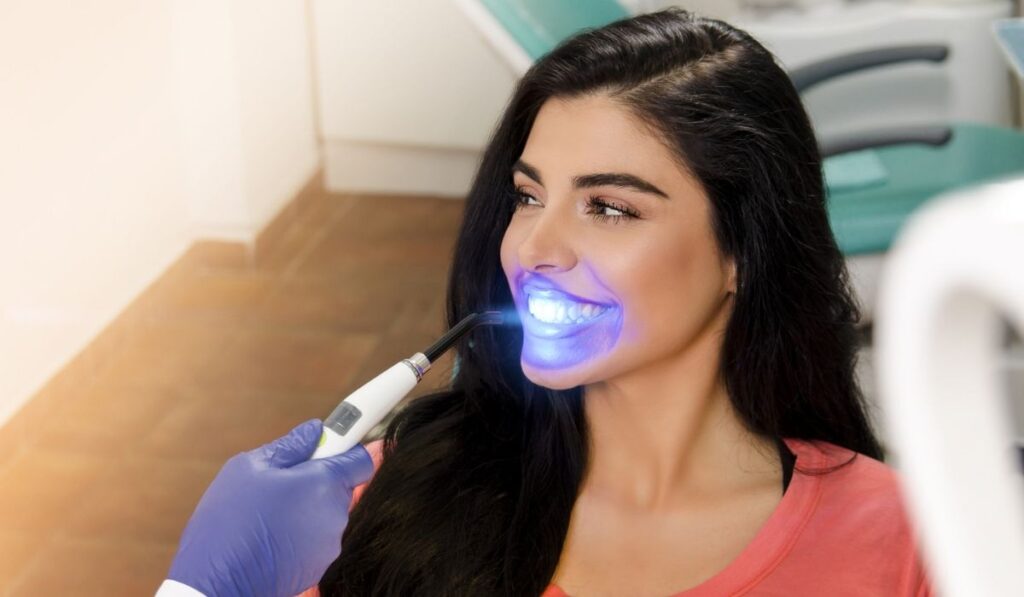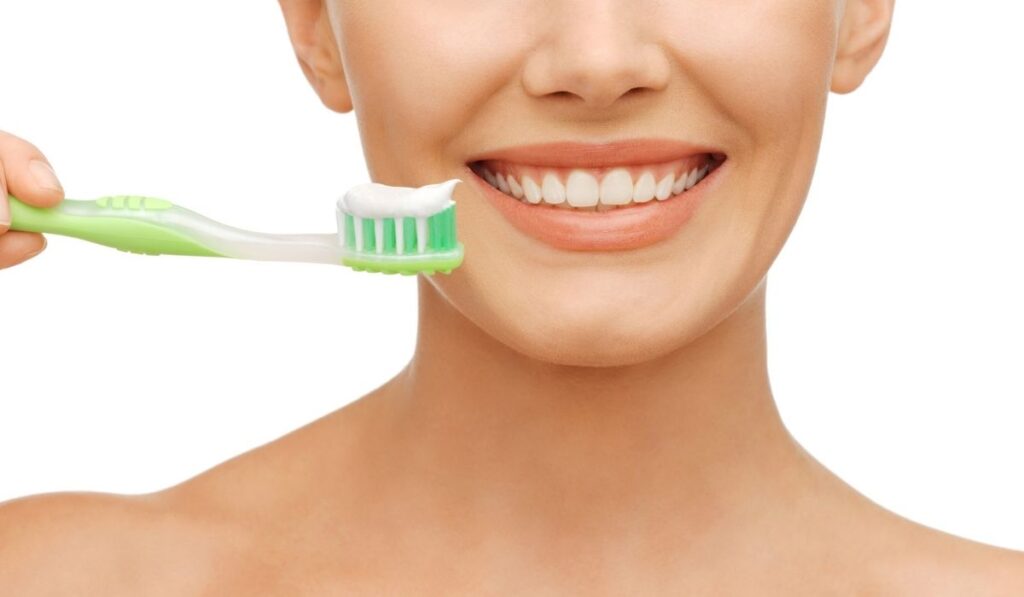Teeth whitening is an incredibly sought-after procedure, and UV teeth whitening has become the most popular out of all the options. This is for good reason – everyone deserves a clean and crisp smile they can be proud of. However, this treatment option comes with its own set of risks and precautions.
UV Teeth Whitening poses short-term risks such as mild burns, increased sensitivity, and bleeding gums when done incorrectly. Most dentists don’t recommend at-home UV kits, as they’re a riskier option. For the best results, all whitening procedures should be done by a professional.
If you’re worried about bleeding gums, don’t call off your next whitening appointment just yet. Although UV teeth whitening poses risks, it can still be a safe procedure. Read on for everything you need to know on UV teeth whitening.
What is UV Teeth Whitening?

UV teeth whitening is a method of whitening teeth that typically uses UV lights along with chemicals. You can find at-home UV and LED teeth whitening kits like the Smilestra Teeth Whitening Kit (on Amazon), or get this treatment done by a professional.
How Does UV Whitening Work?
UV Whitening works by placing a peroxide-based whitening gel on your teeth and placing a blue UV light over the teeth. The thought process behind this is that the light will expedite the whitening process. However, this may not always be the case.
Halogen, LEDs, and UV lights by themselves are not effective at removing stains. The chemicals found in the gel remove the stains, not the lights. Although the jury is still out on whether this is truly an effective treatment option, many dentists use and recommend this technique.
UV Teeth Whitening Safety Concerns
UV teeth whitening seems like the perfect solution whether you opt for professional treatment or the at-home option. However, there are some risks to be aware of when undergoing this procedure.
UV teeth whitening uses ultra-strong lights during the treatment process. If used incorrectly or poorly, UV teeth whitening can damage the soft tissue found within the mouth. This means areas like the cheeks, gums, and tongue can suffer harm. Mild burns or increased sensitivity on the lips is also a concern.
Additionally, UV lights can damage the eyes if misused. Both the dental technician and patient should be wearing eye protection during the procedure. All that being said, patients are much more likely to suffer from the harsh chemicals used during the process.
For these reasons, it’s best to consult with your dentist before beginning any procedure. UV teeth whitening can come with a host of risks, so it’s best left to the professionals.
What About At-Home Whitening Kits?
At-home whitening kits seem like the perfect purchase. Getting your teeth whitened for a fraction of the cost and from the comfort of your home sounds fantastic, right? Unfortunately, this may not always be the case.
Contrary to popular belief, at-home whitening kits actually use LEDs instead of UV. LEDs are notably safer than UV lights and have been adopted by dentists across the nation.
However, these at-home whitening kits are not the same as a professional dental procedure. Dentists use much stronger chemicals that aren’t allowed for retail sale.
Additionally, if done improperly, at-home whitening kits can be dangerous. When purchasing a teeth whitening product, be sure to look for seals of approval from the FDA and American Dental Association (ADA). As always, be sure to speak with your dentist before making any decisions.
Safe Ways to Whiten Your Teeth

UV teeth whitening comes with its fair share of risks. If done improperly, patients can suffer from burns and sensitivity. Fortunately, there are other methods of whitening your teeth that don’t pose as much of a threat.
Baking Soda
Using baking soda as a teeth whitening agent can be hit or miss. Some individuals may suggest baking soda is too abrasive, causing damage to the teeth. However, this may not be the case.
Research has shown that baking soda is reasonably safe as long as you exercise caution. Be sure to use a soft-bristle toothbrush and brush softly. Additionally, do not mix baking soda with lemon juice. Lemon juice is highly acidic and can erode your enamel.
Whitening Strips
Whitening strips can get a bad rap. People often consider at-home whitening strips to be damaging and risky. Fortunately, this is no longer the case.
Products like Crest 3D Whitestrips (on Amazon) have been approved by the American Dental Association, making them trusted for at-home use. As always, be sure to speak with your dentist before purchasing and read all instructions before beginning.
Whitening Toothpaste & Rinses
Whitening toothpaste and rinses are other standard solutions to stained teeth. These products typically contain low amounts of hydrogen peroxide. However, whitening toothpaste and rinses have only been shown to lighten teeth by one or two shades. This makes them a less compelling option.
On top of that, whitening toothpaste can be abrasive, resulting in weakened enamel. However, whitening toothpastes that have the ADA seal of acceptance are safe for daily use and don’t have an unsafe amount of abrasives. You can use a whitening product that has this seal of acceptance for daily use.
Also, whitening rinses can take upwards of three months before showing results. As always, be sure to speak with your dentist before making any changes.
High-Fiber Foods
There are other ways to whiten your teeth besides at-home whitening products. One of these ways is by consuming high-fiber foods. High-fiber foods like broccoli, cauliflower, and other coarse vegetables require you to chew for longer.
Chewing for more extended periods of time increases saliva production. Increased saliva protects your teeth and helps fight stains.
Pineapple
Pineapple is currently the only known source of natural bromelain. Bromelain is an anti-inflammatory and cleaning compound that has been proven to fight stained teeth. Adding pineapple to your diet might lighten your teeth.
Dairy Products
Consuming dairy products is another way to fight stained teeth. Dairy products increase saliva production, ensuring your teeth are well-protected. On top of that, the lactic acid in cheese can help reduce surface stains.
Try Snacking
Dairy products, pineapples, and high fiber vegetables all protect your teeth in some capacity. However, eating at the correct times is crucial to receiving all the benefits.
Try eating a snack with your next sugary or acidic beverage. Eating increases saliva production, which protects your teeth. Eating some cheese or nuts after your morning coffee can also help fight stains.
Avoid Certain Foods
Some foods help protect your teeth, while others damage them. Being aware of certain foods and avoiding them when you can is essential to protecting your teeth. Acidic foods such as citrus should be consumed in moderation, as they can weaken your teeth.
Be mindful of tomato-based sauces, as they are both acidic and likely to stain teeth. Coffee, tea, and red wine should be consumed in moderation, as they are highly likely to stain teeth. Rinse with water immediately after drinking those beverages to reduce staining.
Brush Regularly & Practice Good Oral Hygiene
The best way to fight off stains and damage and whiten your teeth is by practicing good oral hygiene. Be sure to brush and floss your teeth at least twice a day.
You can also rinse your mouth out with water after consuming a stain-causing food. Using a whitening toothpaste once or twice during the week is also recommended.
As always, be sure to speak with your dentist to find out what’s best for you.


